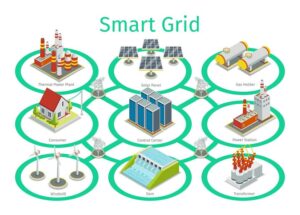HVDC in Smart Grid

The Role of High-Powered DC Transmission Lines in the Smart Grid and Renewable Energy Industry: Pros, Cons, and Barriers to Implementation
As the global push for clean energy gains momentum, efficient and reliable electricity transmission becomes increasingly essential. High Voltage Direct Current (HVDC) transmission lines significantly integrate renewable energy sources into the smart grid. This article examines the benefits and drawbacks of HVDC transmission lines in the smart grid and renewable energy industry and their implementation challenges.
I. Advantages of High-Powered DC Transmission Lines
- Efficiency and Lower Losses HVDC transmission lines boast greater efficiency than their alternating current (AC) counterparts due to reduced transmission losses. As resistance is significantly lower in HVDC lines, less energy is wasted as heat, allowing more extensive power to be transmitted over long distances.
- Interconnection of Asynchronous Grids HVDC transmission lines can seamlessly connect grids at different frequencies, allowing for greater flexibility and efficient management of energy resources.
- Offshore Wind Integration The efficient transmission of power from offshore wind farms to onshore grids is made possible through HVDC technology. This enables the large-scale deployment of offshore wind resources and helps meet growing energy demands.
- Reduced Infrastructure Costs HVDC transmission lines require fewer conductors and less insulation, reducing overall infrastructure costs. Additionally, the compact nature of HVDC lines allows for easier installation in dense urban areas.
II. Disadvantages of High-Powered DC Transmission Lines
- High Initial Investment Despite the long-term savings and efficiency benefits, HVDC transmission lines require substantial initial investments in converters and other supporting infrastructure.
- Limited Fault Detection and Protection Compared to AC systems, HVDC technology has limited fault detection and protection mechanisms. This can pose challenges in maintaining the reliability and security of the grid.
- Converter Station Vulnerability HVDC systems rely on converter stations, which are susceptible to failure due to their complex nature. A failure at a converter station can result in the loss of power transmission, impacting grid stability and reliability.
III. Barriers to Implementation
- Regulatory and Institutional Challenges Implementing HVDC transmission lines often involves multiple jurisdictions, resulting in regulatory and institutional challenges that can delay or hinder projects.
- Lack of Standardization: The absence of universally accepted standards for HVDC technology can limit system interoperability and slow deployment.
- Public Perception and Environmental Concerns Resistance from local communities and concerns about the environmental impact of HVDC transmission lines can impede their implementation.
Conclusion
High-powered DC transmission lines play a vital role in the smart grid and renewable energy industry, offering a more efficient and reliable method for transmitting electricity. Despite the drawbacks and barriers to implementation, HVDC technology remains a promising solution for integrating renewable energy sources and developing a more resilient and sustainable energy infrastructure. As renewable energy becomes increasingly important in meeting global energy demands, the continued advancement and adoption of HVDC technology will play a crucial role in shaping the future of the energy landscape.